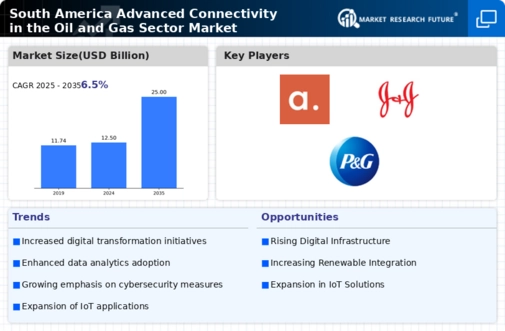Rising Demand for Energy
The rising demand for energy in South America significantly influences the Global South America Advanced Connectivity in the Oil and Gas Sector Market Industry. As economies grow, the need for reliable energy sources intensifies, prompting oil and gas companies to enhance their operational capabilities. This demand drives investments in advanced connectivity solutions that facilitate efficient resource extraction and distribution. The market's growth trajectory suggests a compound annual growth rate of 6.5% from 2025 to 2035, reflecting the sector's responsiveness to evolving energy needs and the necessity for improved connectivity.
Market Growth Projections
The Global South America Advanced Connectivity in the Oil and Gas Sector Market Industry is projected to experience substantial growth over the coming years. With a market value of 12.5 USD Billion in 2024, the industry is expected to expand to 25 USD Billion by 2035. This growth is indicative of the increasing importance of advanced connectivity solutions in enhancing operational efficiency and meeting the rising energy demands. The anticipated compound annual growth rate of 6.5% from 2025 to 2035 underscores the sector's potential for innovation and investment, reflecting a robust outlook for stakeholders.
Technological Advancements
Technological advancements play a pivotal role in shaping the Global South America Advanced Connectivity in the Oil and Gas Sector Market Industry. Innovations such as IoT, AI, and big data analytics are being integrated into operations, enhancing efficiency and decision-making processes. For example, companies are utilizing real-time data analytics to optimize drilling operations and reduce downtime. This trend not only improves productivity but also aligns with sustainability goals by minimizing environmental impact. As these technologies become more prevalent, the market is expected to grow significantly, potentially reaching 25 USD Billion by 2035.
Investment in Infrastructure Development
The Global South America Advanced Connectivity in the Oil and Gas Sector Market Industry is witnessing substantial investment in infrastructure development. Governments and private entities are increasingly allocating resources to enhance connectivity, which is crucial for efficient operations in remote oil and gas fields. For instance, the Brazilian government has initiated projects aimed at upgrading transportation and communication networks, which are expected to facilitate smoother logistics and data transfer. This investment is projected to contribute to the market's growth, with an estimated value of 12.5 USD Billion in 2024, reflecting a robust commitment to modernizing the sector.
Regulatory Support and Policy Frameworks
The Global South America Advanced Connectivity in the Oil and Gas Sector Market Industry benefits from supportive regulatory frameworks established by various governments. Policies aimed at promoting energy security and environmental sustainability encourage investments in advanced connectivity solutions. For instance, Colombia's regulatory body has introduced incentives for companies adopting innovative technologies that enhance operational efficiency. This regulatory support is likely to foster a conducive environment for growth, as stakeholders recognize the importance of connectivity in achieving compliance and operational excellence.
Focus on Sustainability and Environmental Responsibility
Sustainability and environmental responsibility are becoming increasingly critical in the Global South America Advanced Connectivity in the Oil and Gas Sector Market Industry. Companies are under pressure to adopt practices that minimize their ecological footprint while maintaining operational efficiency. This shift is prompting investments in advanced connectivity technologies that enable better monitoring and management of environmental impacts. For example, firms are leveraging remote sensing and data analytics to track emissions and optimize resource use. As sustainability becomes a priority, the market is likely to evolve, aligning with global trends towards greener energy practices.














Leave a Comment